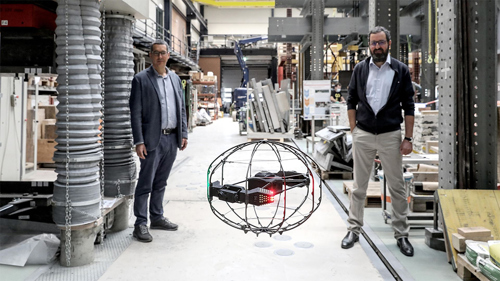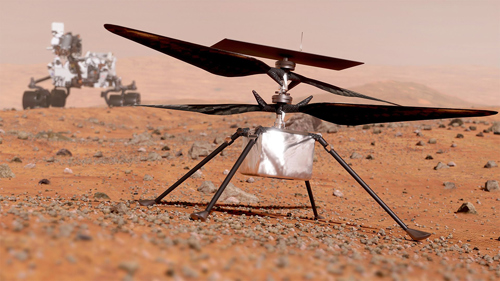Although legislation currently holds back widespread commercial deployment of drones, trials are showing the potential for cargo delivery, as well as applications such as inspection and security. Key to achieving flight safety, as well as power efficiency, are drone propulsion systems. maxon’s engineering expert for aerospace applications, Andrew Gibson, discusses the status of the drone market and the future requirements for drone propulsion systems.
Last summer, Royal Mail began the trial of drone delivery for payloads up to 6kg in the Orkney Islands. While the geography of the Orkneys lends itself to the advantages of drone flight, and the sparse population reduces safety concerns, lightweight deliveries by drone have also been taking place in Dublin. Drone firm Manna has been delivering products like groceries and medical supplies to homes in the Blanchardstown suburb since February this year.
Despite the success of these trails, a key reason why the commercial use of drones hasn’t been more widespread are the inherent safety concerns of flight taking place close to people and infrastructure. These concerns are backed up by legislation on drone flight. In general in the UK, the current ruling prevents beyond visual line of sight (BVLOS) unmanned flight, meaning that the drone pilot has to maintain continual, unaided, eyesight to the aircraft. While aviation safety regulators in the UK, as well as Europe and the US, are cautious about relaxing the rules, the UK government is currently reviewing the potential of allowing BVLOS for certain purposes , such as infrastructure inspection.
BVLOS isn’t the only challenge, and there are also issues surrounding flight path flexibility. For operation in urban environments, such as grocery delivery, drones would need freedom over route selection. As well as regulations to avoid collisions with other airspace users, developments in Unmanned Aircraft System Traffic Management (UTM) system technology are also required to control airspace and ensure flight safety.

Andrew Gibson, discusses the status of the drone market and the future requirements for drone propulsion systems
The flexibility of lightweight drones
The current legislative restraint, combined with the practicality of carrying a greater payload, means that some drone developers are looking at the potential of heavy lift and middle-mile delivery, particularly to serve more remote communities. Drones like the Dronamics Black Swan resemble conventional aircraft, with a 16m fixed wing and a payload of 350kg, yet craft like this need a conventional runway, compared to a drone pad measuring a couple of metres wide.
Yet despite the challenges, the inherent flexibility of the lightweight drone means that firms such as Amazon are still pressing ahead with designs at this scale. The company says that by the end of the year, it’s Prime Air service will start deliveries in the UK up to a payload of 2.26kg , while maxon has also been working on propulsion for payloads up to 15kg.
But lightweight drone technology has wider application potential too. It’s use for security purposes, aided by HD cameras and thermal identification technology, has been transferred to search & rescue work, both in the UK as well as global humanitarian emergencies. The ease and speed of drone operation also optimises efficiency for industrial inspection and asset monitoring, with use covering buildings through to wind turbines, as well as shipping . Agriculture can also benefit from drones, speeding up processes such as crop monitoring, and practical duties such as spraying.

maxon - flybotix-warehouse
Drone propulsion system development
In step with any potential for expanded drone use, the regulations on drone technology safety are likely to be strengthened in response. Here, the drive systems that power a drone or unmanned aerial vehicle (UAV), comprising the motor, propeller, and speed controller, are fundamental.
In readiness for more robust regulation, we’ve put our drone and UAV drive systems through an internal test procedure that matches the RTCA DO-160 G Environmental Conditions and Test Procedures for Airborne Equipment. Applicable to all commercial aircraft, from drones to the latest passenger airliners, this the most rigorous standard that specifies the test conditions for the design of avionics electronic hardware in airborne systems.
Drone design commonly integrates a redundancy overlap, where a craft could continue to fly, albeit at reduced performance, on a reduced amount of operational rotors. Yet to achieve future regulation, as well as the real practicalities of safe and reliable operation in the most testing environmental conditions, the drive system that powers a drone must be able to reliably perform. Achieving this requires a design that prevents ingress, enables high thermal regulation, and can withstand vibration and impact.
Beyond the imperatives of safety and reliability, optimising torque density is also key to performance. Crucially, a lightweight, torque-dense motor can achieve a higher payload, increasing value and practicality for the operator. This capability can also mean increased airtime, with a lower energy demand and a less frequent need to recharge. In a similar way, the drive system also needs to maximise energy efficiency in order to rely on a smaller, lighter battery. Thanks to these attributes, NASA selected maxon motors on its groundbreaking Mars drone, Ingenuity, to control the swashplate, critical to change the pitch of the rotor blades.

maxon motors powered the swashplate on the NASA Ingenuity Mars drone
Customisation combined with scale manufacturing
Most projects, not just NASA, require propulsion system customisation to optimise the desired capabilities for the particular role the drone needs to fulfil. This could relate to aspects such as managing the diameter and pitch of the propellers for efficiency gains, to specifying a certain motor configuration to optimise torque density.
Flexibility over design parameters not only maximises flight characteristics, but also helps turn a drive system into a commercially viable drone power plant. Combining high scale manufacturing from a customised design, this approach to propulsion system development enables a drone builder to achieve the specification they need - and pass on value to their market.
The drone market itself is a dynamic environment, and legislative changes over the next five years could be pivotal to the direction the sector takes. If the potential of launching lightweight drones is realised, what is for certain will be the dependence on reliable and efficient drive technology.











